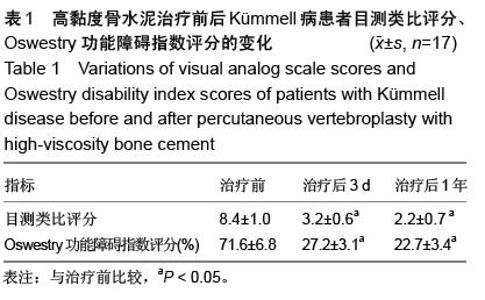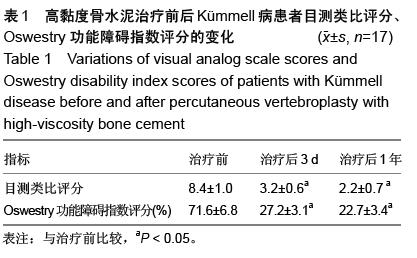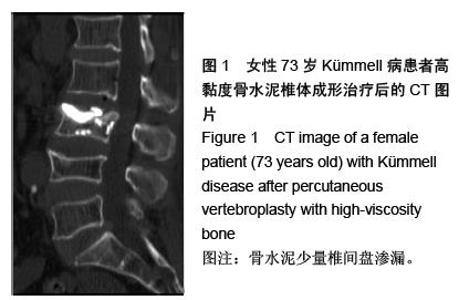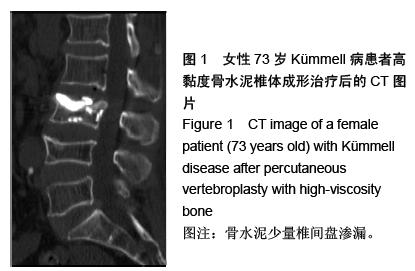| [1] Kümmell H.Die rarefizierende ostitis der Wirbelkorper. Dentache Med.1895; 21(1):180-181.
[2] Matzaroglou C,Georgiou CS,Panagopoulos A,et al. Kummell's Disease: Clarifying the Mechanisms and Patients' Inclusion Criteria. Open Orthop J. 2014;8: 288-297.
[3] Kim YC,Kim YH,Ha KY.Pathomechanism of intravertebral clefts in osteoporotic compression fractures of the spine.Spine J.2014;14(4):659-666.
[4] Wang D,Wang L,Xu J,et al.Value of forceps biopsy and kyphoplasty in Kummell's disease. Orthopedics. 2013; 36(8):e1014-1019.
[5] Huang Y,Peng M,He S,et al.Clinical Efficacy of Percutaneous Kyphoplasty at Hyperextension Position for Treatment of Osteoporotic Kummell's Disease.J Spinal Disord Tech. 2015.[Epub ahead of print].
[6] Sanal B,Nas OF,Buyukkaya R,et al.Kummel Disease and successful percutaneous vertebroplasty treatment. Spine J. 2015;15(11):e9-e10.
[7] Niu J,Song D,Zhou H,et al.Percutaneous Kyphoplasty for the Treatment of Osteoporotic Vertebral Fractures with Intravertebral Fluid or Air: A Comparative Study. J Spinal Disord Tech.2015.[Epub ahead of print]
[8] Kong LD,Wang P,Wang LF,et al.Comparison of vertebroplasty and kyphoplasty in the treatment of osteoporotic vertebral compression fractures with intravertebral clefts. Eur J Orthop Surg Traumatol. 2014;24 Suppl 1:S201-208.
[9] Wu AM,Ni WF,Weng W,et al.Outcomes of percutaneous kyphoplasty in patients with intravertebral vacuum cleft.Acta Orthop Belg. 2012;78(6):790-795.
[10] Baroud G,Crookshank M,Bohner M.High-viscosity cement significantly enhances uniformity of cement filling in vertebroplasty: an experimental model and study on cement leakage.Spine (Phila Pa 1976). 2006;31(22):2562-2568.
[11] Zhang L,Wang J,Feng X,et al.A comparison of high viscosity bone cement and low viscosity bone cement vertebroplasty for severe osteoporotic vertebral compression fractures.Clin Neurol Neurosurg. 2015; 129:10-16.
[12] Wang CH,Ma JZ,Zhang CC,et al.Comparison of high-viscosity cement vertebroplasty and balloon kyphoplasty for the treatment of osteoporotic vertebral compression fractures.Pain Physician. 2015;18(2): E187-194.
[13] 张亮,王静成,冯新民,等.唑来膦酸在骨质疏松性椎体压缩骨折椎体后凸成形术后的应用[J].实用医学杂志, 2015, 31(2):126-128.
[14] Ma R,Chow R,Shen FH. Kummell's disease: delayed post-traumatic osteonecrosis of the vertebral body.Eur Spine J.2010;19(7):1065-1070.
[15] Wu MH,Huang TJ,Cheng CC,et al.Role of the supine lateral radiograph of the spine in vertebroplasty for osteoporotic vertebral compression fracture: a prospective study. BMC Musculoskelet Disord. 2010;11:164.
[16] Matzaroglou C,Georgiou CS,Assimakopoulos K,et al. Kummell's disease: pathophysiology, diagnosis, treatment and the role of nuclear medicine.Hell J Nucl Med. 2011; 14 (3):291-299.
[17] Wu AM,Chi YL,Ni WF.Vertebral compression fracture with intravertebral vacuum cleft sign: pathogenesis, image, and surgical intervention.Asian Spine J.2013; 7(2):148-155.
[18] Freedman BA,Heller JG.Kummel disease: a not-so-rare complication of osteoporotic vertebral compression fractures.J Am Board Fam Med. 2009;22(1):75-78.
[19] Ryu CW,Han H,Lee YM,et al.The intravertebral cleft in benign vertebral compression fracture: the diagnostic performance of non-enhanced MRI and fat-suppressed contrast-enhanced MRI.Br J Radiol. 2009;82(984):976-981.
[20] Ishiyama M,Numaguchi Y,Makidono A,et al. Contrast- enhanced MRI for detecting intravertebral cleft formation: relation to the time since onset of vertebral fracture. AJR Am J Roentgenol. 2013;201(1):W117-123.
[21] 王根林,杨惠林,朱雪松,等.骨质疏松性椎体骨坏死的诊断及椎体后凸成形术治疗[J].中国脊柱脊髓杂志, 2013, 23(3): 228-232.
[22] 蔡俊,冯新民,王静成,等.晚期椎体骨坏死两种治疗方法的疗效[J].江苏医药,2015,41(2):170-172.
[23] Wiggins MC,Sehizadeh M,Pilgram TK,et al.Importance of intravertebral fracture clefts in vertebroplasty outcome. AJR Am J Roentgenol.2007;188(3):634-640.
[24] Krauss M,Hirschfelder H,Tomandl B,et al.Kyphosis reduction and the rate of cement leaks after vertebroplasty of intravertebral clefts.Eur Radiol. 2006; 16(5):1015-1021.
[25] Wang G,Yang H,Chen K.Osteoporotic vertebral compression fractures with an intravertebral cleft treated by percutaneous balloon kyphoplasty. J Bone Joint Surg Br. 2010; 92 (11): 1553-1557.
[26] Kim DY,Lee SH,Jang JS,et al.Intravertebral vacuum phenomenon in osteoporotic compression fracture: report of 67 cases with quantitative evaluation of intravertebral instability. J Neurosurg.2004;100 (1 Suppl Spine):24-31.
[27] Grohs JG,Matzner M,Trieb K,et al.Treatment of intravertebral pseudarthroses by balloon kyphoplasty.J Spinal Disord Tech. 2006;19(8):560-565. |



